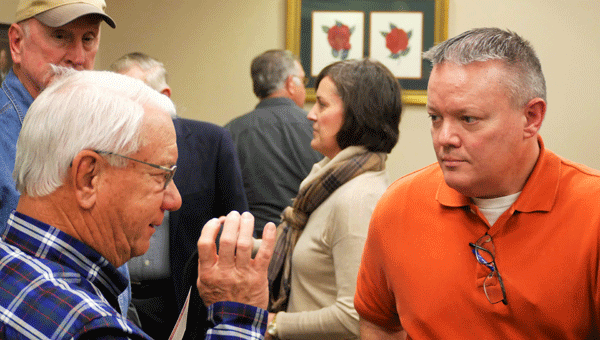Jackson opens windows to ‘Becoming Alabama’
Published 10:15 am Wednesday, January 31, 2018

- Meeting attendee Johnny Autrey talks with Foley Public Library director John Jackson after Jackson’s presentation “Becoming Alabama” for the Butler County Historical and Genealogical Society last Sunday. In spite of the inclement weather, a full house was present at city hall to hear Jackson’s talk on the state’s early inhabitants and the impact made by French and Spanish explorers in the region.
Native Americans once paddled up and down waterways through its swamps and verdant forests. Later, conquistadors from Spain came to claim the land for God, glory—and the glittering treasures they believed could be found among the indigenous people. The French arrived, too, eager to establish their own outposts in the New World and to trade with native tribes, some even “going native” themselves.
It was all a part of “Becoming Alabama,” the featured topic for the quarterly meeting of the Butler County Historical and Genealogical Society last Sunday in Greenville.
John Jackson, the current director of the Foley Public Library and the former director of the Baldwin County Department of Archives and History, shared the highlights of what is normally a three-part class on the early inhabitants and historic milestones of the region before Alabama achieved statehood in 1819.
“When we go back to the earliest years of the indigenous people . . . we see that they weren’t settled into villages. They were seasonal adventurers who moved up and down the waterways and that continued until later, when we saw the various Indian tribes emerge [Creeks, Chickasaws, Cherokees and Choctaws],” explained Jackson, who is also a veteran history teacher.
Before the explorers came, there were once many, many more native Americans here in North America, probably in the neighborhood of 3-4 million. However, once the Europeans arrived on these shores, the indigenous people began to suffer the consequences of being exposed to new diseases. Their population dropped to approximately 250,000 to 300,000. Here in what would become Alabama, the population was diminished from 200,000 to roughly 30,000 natives by the time of de Soto’s arrival.
“And [mass death due to exposure to disease] was not unusual; it happened pretty much everywhere the Europeans went.”
While many Alabamians are familiar with Moundville and its ancient Indian dwellings, “many may not know about the Bottle Creek mounds located in Baldwin County,” Jackson said.
He described the Bottle Creek Mounds as a fascinating place to visit, but not on your own.
“It’s surrounded in a thick jungle and it’s inaccessible for about 75 percent of the year. The best time of year to go is in the fall, and tours can be arranged through the Five Rivers Delta Museum. It is a wonderful window into just how advanced the culture was prior to the arrival of the Europeans.”
Not only did the Indians suffer from newly imported illnesses courtesy of the explorers, they were also exposed to new and wondrous things, such as firearms and horses.
“Can you imagine what it was like when the Spanish conquistadors rode in like gods on these great beasts, and they would fire these weapons with a puff of smoke and your friend yards away fell over dead. This was magic,” Jackson said.
He explained that what ultimately happened to the Native American population is not a rarity in history, saying,“No one becomes the predominant people in a region without superseding someone else.”
It would be a book by a survivor of an ill-fated expedition, Cabeza de Vaca, that would inspire Hernando de Soto’s explorations.
The conquistadors had a clear agenda—to spread Christianity and to get rich while doing it. Any natives who didn’t agree to convert to the new religion were quickly eliminated.
“By 21st century standards, this is terrible, but you have to understand this was business as usual for these soldiers,” Jackson explained. “It was a ‘take no prisoners’ attitude.”
De Soto and his men were frequently directed by the locals they encountered to continue to the north where they would surely find the gold they sought (“The Indians were catching on”).
Ultimately, the Indians invited de Soto to come and meet Chief Tuscaloosa at a walled town called Maubila—a ruse to draw the explorer and his men to the spot and destroy them. A battle broke out with casualties on both sides. De Soto and some of his men escaped after setting fire to the town.
“We do not know the exact location of Maubila, but it was possibly located in north Baldwin County,” Jackson said.
While the great hordes of gold they anticipated as they continued their travels into the continent never materialized, the conquistadors left behind a very long-lasting legacy in America—horses and hogs.
The French explorers who came to the southern portion of the New World originally tried to settle in what is present-day Biloxi, Miss., but its low-lying, swampy, disease-ridden state made them change their minds.
“So they came to the Mobile area and established a settlement on 27 Mile Bluff . . . theirs was a different approach from the Spaniards. The French focused on trade with the Indians and adopting a laissez-faire attitude. Some even went native,” Jackson explained.
The inconvenience of the bluff location, flooding issues and the spread of illness made the French decide they had to find a better site—Mobile.
“Look at this photo of present-day Mobile and there is Fort Conde. It’s amazing how much of it is still so well preserved,” Jackson pointed out.
The French remained active in this part of the world until the French and Indian ( or Seven Year’s) War ending in 1763—the “first Civil War fought on the North American continent,” Jackson said.
France’s ultimate loss forced them to give up their territories in Canada (which went to the British) while allowing them to keep their sugar islands in the Caribbean.
While Jackson’s talk focused on Spain’s and France’s impact on the region, he also responded to a question about Britain’s approach to colonization here.
“The British, as with the French and Spanish, tried to reconstruct what they knew best. In Ireland, the British had chosen to exterminate enough of the local population until it was at a controllable number and then install entrepreneur families to establish long-term commerce and trade,” Jackson said.





